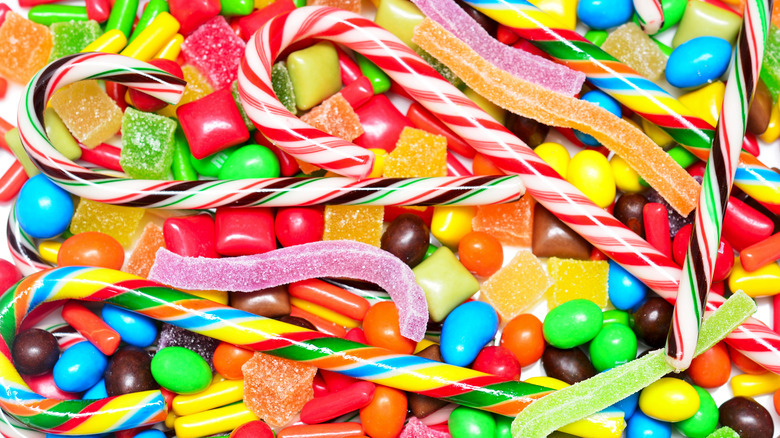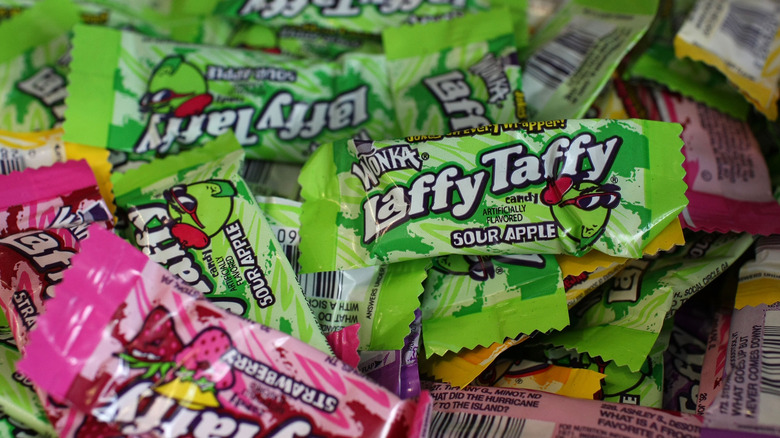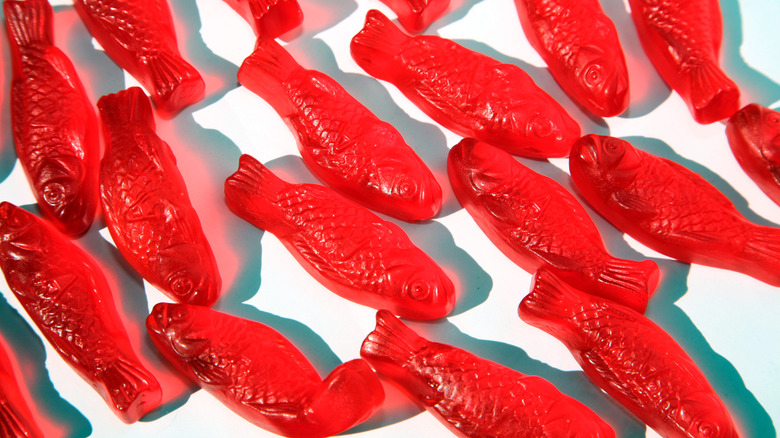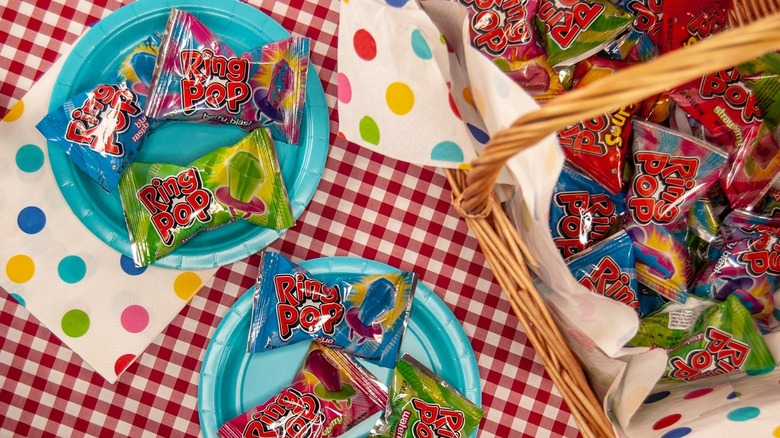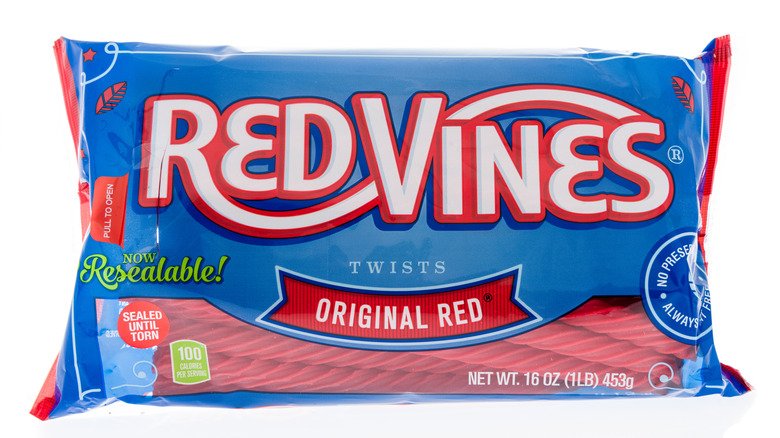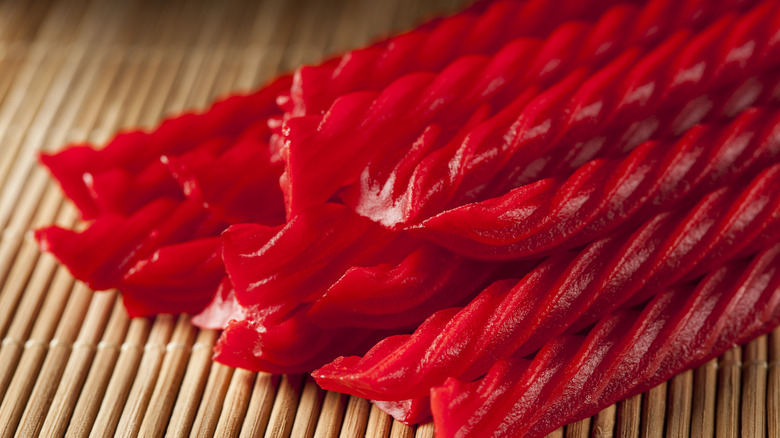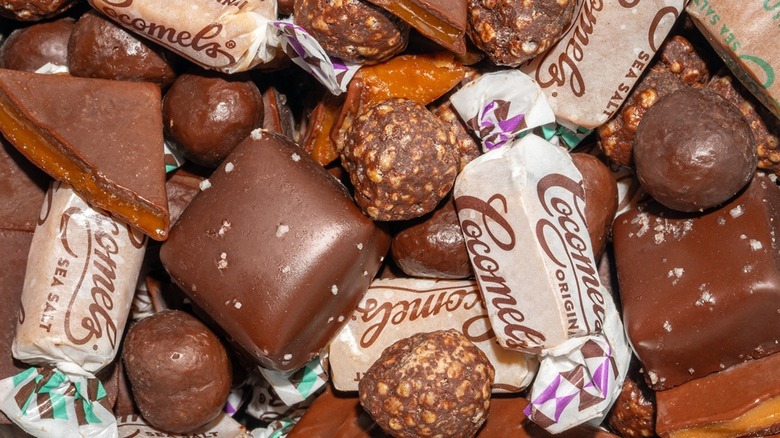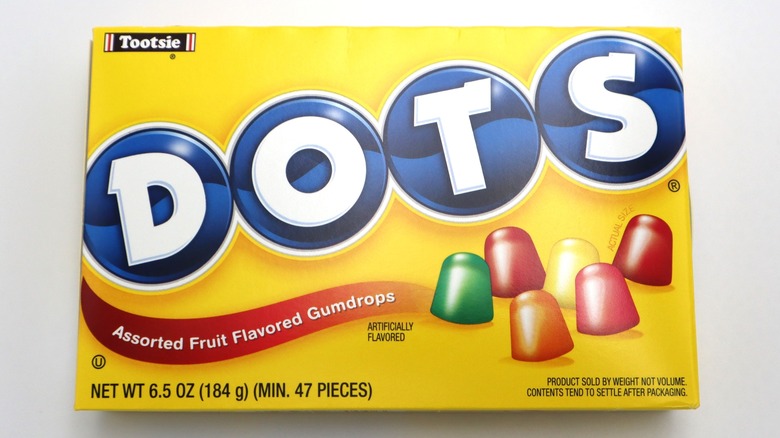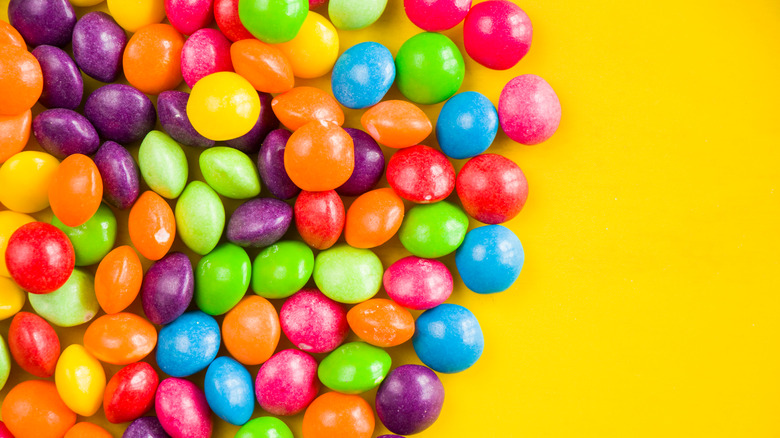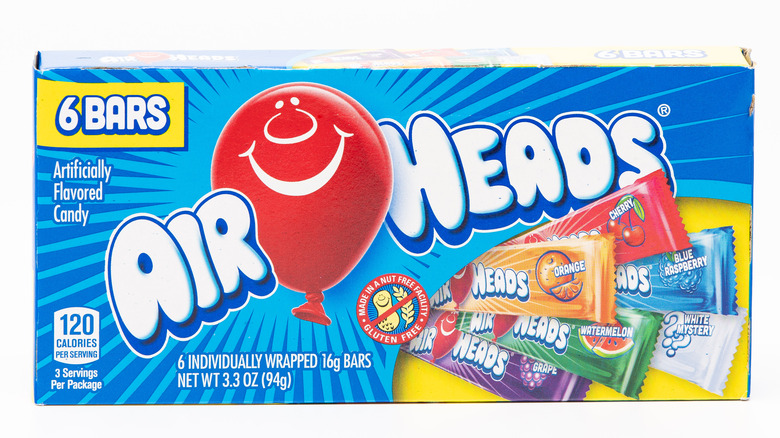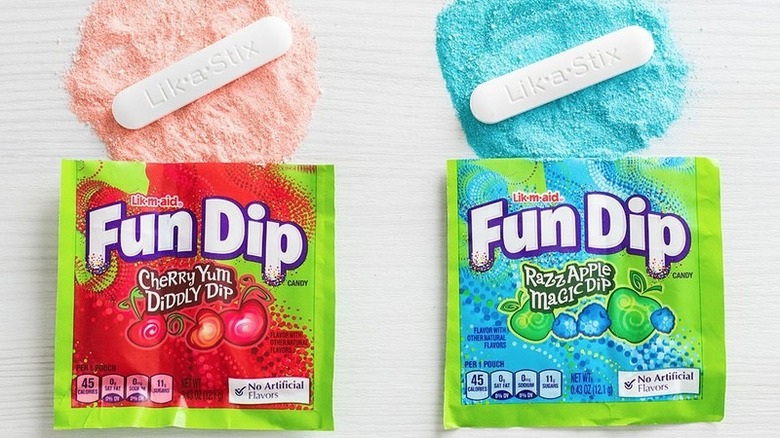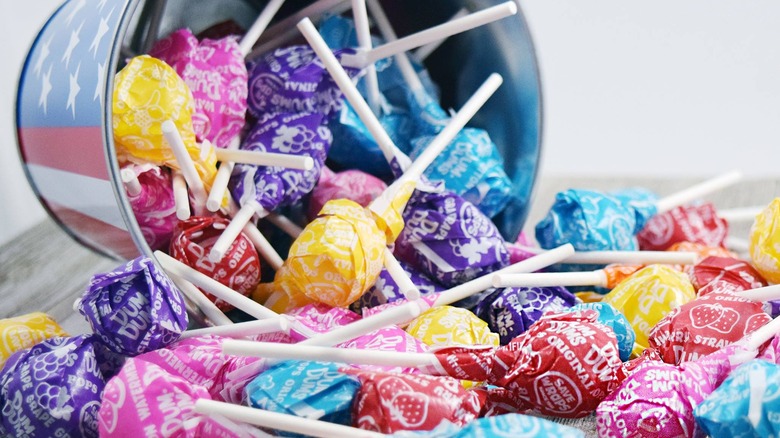Vegan Candy Guide: The Brands You Didn't Know You Could Eat
If you're vegan (or shop for one), you know the struggle of finding candy that contains no animal-derived ingredients. You likely already have your list of cuisines that are notably vegan-friendly, but sweets are a little harder to pin down. As a result, when candy-heavy holidays like Halloween or Easter roll around, you may find yourself staring at one ingredient label after another, searching for classic confections that fall into "accidentally vegan" territory. Do your old childhood favorites contain gelatin, beeswax, casein, carmine (also known as "natural red 4"), shellac, or any number of other components you want to eschew as a vegan?
Further compounding this is the fact that intuition doesn't really work when it comes to sniffing out animal-sourced ingredients in candies. Sure, it's a no-brainer that milk chocolate M&Ms contain milk chocolate, but Starbursts, for instance, contain gelatin despite their whole fruit-centric vibe. Still, there's a surprisingly wide variety of vegan-friendly candies out there that may not be on your radar. Rather than miss out on a whole world of sugary goodness, here are 12 vegan candy brands to add to your can-eat list.
Laffy Taffy Minis and Ropes
Besides its fun-to-say name, Laffy Taffy's fun-to-chew texture and fun-to-read labels make it a candy you can't help but crave every now and then. There are a lot of fun facts about Laffy Taffy, not least of which is the history of its name. The sweet started life as "Breich's caramels" in the 1970s, but "Laffy Taffy" replaced "caramels" not long afterward — a fitting change considering the candy's stretchy texture and the quirkiness of the quips in its wrappers, all written by children.
Laffy Taffy's vegan status highlights a common trend among candies: Some versions are vegan while others aren't. In this case, Laffy Taffy Minis and Ropes contain no animal-derived ingredients. Specifically, they contain corn syrup, sugar, palm oil, mono- and diglycerides, hydrogenated cottonseed oil, salt, soy lecithin, natural flavor, and food coloring such as yellow 5, blue 1, or red 40. In the stretchy and tangy varieties, however, you'll find egg albumen, making them unsuitable for vegan eaters. Be aware that the sugar and palm oil in vegan Laffy Taffy can be controversial ingredients for those following a vegan lifestyle: The former for its potential processing with bone char and the latter for its impact on the lives of animals. Still, these components are technically vegan.
Swedish Fish
Swedish Fish have been a sugary staple in the United States since the 1950s, when they "swam" over from their original home in — yes, for real — Sweden. Vegans who enjoyed this unique fruity confection before making the switch to veganism will be happy to hear that, despite their chewy texture, Swedish Fish do not contain gelatin, common in gummy candies, or any other animal-sourced ingredients. What you will find is sugar, invert sugar, corn syrup, modified corn starch, less than 2% citric acid, white mineral oil, natural and artificial flavor, red 40, and carnauba wax. Carnauba wax, in case you were wondering, is vegan-friendly.
Beeswax, however, is a biggie on the vegan do-not-eat list. One of the most important things vegans need to know about Swedish Fish is that, for whatever reason, some peg bags of Swedish Fish contain beeswax. This means that if you're in a gas station or other venue where the candies are all hanging for your perusing pleasure, make sure to mind your beeswax and check that the Swedish Fish are of the vegan variety.
Ring Pops
King of the edible candy props since 1977, Ring Pops are another sweet heavy on childhood nostalgia. One of the cutest untold truths about Ring Pops is that their creator, Frank Richards, invented them in an attempt to help his daughter stop sucking her thumb. Whether the sweet worked for this purpose or not, we don't know. But his efforts did spawn a wildly popular candy (especially for Halloween) that just so happens to be vegan-friendly. The coloring agents used in each ring flavor are different, but the main ingredients remain the same: sugar, corn syrup, lactic acid, sodium lactate, and artificial flavor.
If you're concerned about the lactic acid and sodium lactate, worry not: Although they may sound dairy-related (think "lactose"), lactic acid and sodium lactate are both vegan. What's not vegan, however, are any Ring Pop Gummy varieties, which contain gelatin. So stick to the hard stuff, and you'll be fine.
Red Vines
If there's such a thing as pedigrees among the candy brand families, Red Vines come from royalty. It's a product of the American Licorice Company, which Charlie Chaplin once commissioned to make a licorice shoe for him to eat in "The Gold Rush." Black licorice sticks had been the company's mainstay product since 1914 — the shoe-shaped edible was a one-off — but in the 1950s, it introduced a red, fruit-flavored variety: Raspberry Vines. The public affectionately nicknamed these movie theater staples "red licorice twists" despite the candy's lack of actual licorice extract, and at some point, the American Licorice Company officially branded them as Red Vines.
Throughout all these changes and developments, one thing has remained the same: Red Vines are vegan-friendly with their ingredient list of corn syrup, wheat flour, high fructose corn syrup, citric acid, artificial flavor, and red 40. The grape and mixed berry flavors are vegan-friendly as well, though the exact flavorings and coloring agents can vary. If you're thinking of picking up the limited edition Red Vine ropes, however, you may want to hold off. They're made with glyceryl monostearate, which can be derived from either animal fats or plant-based sources.
Twizzlers
Twizzlers are another pseudo-licorice candy with craveable qualities: Nearly 200 tons of them are made each day by Hershey in Lancaster, Pennsylvania. A different company originally set this popular sweet in motion, though: Y&S Candies (formerly Young and Smylie) sold the first Twizzlers in 1929, a whole 84 years after the business's founding. Game-changing products come to companies who wait, it appears. Twizzlers might be the only candy that's received a mention from space: Neil Armstrong admitted having a hankering for the red twists while on the moon. Whether Armstrong's endorsement had any influence on The Hershey Company purchasing Y&S Candies in 1977, we don't know, but it couldn't have hurt.
There are a few differences between Red Vines and Twizzlers, but vegan-friendliness is one thing they have in common. Twizzlers, like their red licorice competitor, contain no animal-derived components, making them can-eats for a vegan lifestyle. However, the Twizzlers ingredient list is a bit longer than that of their rival, and, unlike Red Vines, does include sugar and palm oil, two contentiously vegan ingredients.
Cocomels
First sold in 2010, Cocomels are a newer confection compared to some on our list, but they average close to five-star ratings across Amazon and iHerb from thousands of customer reviews. Their creator, JJ Rademaekers, clearly knew what he was doing when he conceived of a caramel made with coconut milk rather than dairy. Today, Cocomels are an exemplary candy when it comes to dietary inclusion. The original flavor was a revelation at the time: A keto-friendly Halloween candy that didn't go wild marketing itself as keto food. Subsequent iterations like coconut sugar Cocomels meant the candy could be enjoyed by those seeking a lower glycemic sweetener. There are even a few varieties containing less than 1 gram of sugar.
Another sweet fact about Cocomels: They're all vegan (not to mention organic). The original Cocomels contain organic coconut milk, organic brown rice syrup, organic dried cane syrup, sea salt, and xanthan gum. Although Cocomels are dairy-free, the manufacturer does note that the equipment the candy is produced with may also be used for products that contain dairy. While the company can't guarantee that Cocomels are 100% free from dairy traces, it does utilize an allergen cleanse protocol and testing to lower the risk of cross-contamination.
Dots
An iconic classic, Dots may be the first gumdrop that many of us encountered in our candy-loving lives. Like Red Vines, these colorful drops of sweetness began as black licorice in the 1890s, but they upgraded to a fruity flavor profile and a fun range of colors in 1945. The original lineup included orange, lime, cherry, strawberry, and lemon — the same flavors you'll find in a box of regular Dots today. You can't improve on perfection, apparently, and consumers agree. Tootsie Roll Industries' Chicago facility produces a whopping four billion Dots each year.
Dots now come in sour and tropical varieties in addition to the original, and they're all vegan-friendly. The original and tropical Dots consist of corn syrup, sugar, food starch-modified, malic acid, natural and artificial flavors, sodium citrate, and artificial colors, including FD&C red 40, yellow 5, and blue 1. Sour Dots contain the same ingredients with the addition of palm oil.
Skittles
Another fruity favorite, Skittles have had Americans "tasting the rainbow" since they hit our shelves in 1979, five years after their release in the United Kingdom. Skittles come in five flavors and corresponding colors: strawberry, lime, grape, lemon, and orange. Those flavors made news back in 2018 when, as Today reported, social media exploded with rumors that all Skittles have the same taste despite their color. However, the candy's manufacturer, Mars Wrigley Confectionery, laid the rumor to rest.
One thing that is undeniable about Skittles, though, is their vegan-friendly status. The ingredients list is on the longer side but unequivocally contains no animal-derived ingredients. You'll find pretty much all the usual candy components in a pack of original Skittles, along with two newcomers to our list: tapioca dextrin and titanium dioxide. Both are vegan. So feel free to scarf down a pack of Skittles to ward off a post-lunch slump or sprinkle them as a topping for your dairy-free frozen yogurt. Just avoid the gummy variety, as those contain that usual squishy-candy suspect: gelatin.
Airheads
Airheads, another form of fruity, taffy-style candy, are immediately recognizable by the smiling balloon head cartoon on their label. That graphic — plus the entire concept of Airheads itself — was the brainchild of Steve Bruner, who had signed an intellectual property agreement with Van Melle Incorporated and thus never made a penny off the candy. The Airheads story is filled with trial and error, setback and luck, but one thing the candy isn't filled with is animal-derived ingredients: Airheads are vegan.
Original Airheads contain the typical ingredients found in most vegan candies. In this lineup, however, you'll also find maltodextrin, dextrose, and yellow 6. This last ingredient is one some vegans prefer to eschew as its production involves animal testing, though it contains no animal-sourced ingredients itself. One thing to note: If you're considering picking up a pack of Airhead Bites or Gummies, think again. Both contain beeswax, and the Bites are also made with shellac, while the Gummies contain (take a wild guess!) gelatin.
Fun Dip (and Pixy Stix)
The modus operandi for consuming Fun Dip is one of the most unique we know of in the realm of candy: Dip a sugar stick into a pouch of flavored sugar and lick it off. While doing so, you may notice the word "Lik-m-Aid” featured at the top of the package. This was the name of the first incarnation of the sweet, back in the 1950s, when kids either used their finger as a dipstick or just licked the powder out of the bag. The stick (Lik-a-Stix) wasn't added until 1973 when the candy was rebranded as Fun Dip.
If you ate a wide variety of candies as a child, you may have noticed a similarity between Fun Dip (AKA Lik-m-Aid) and the stuff you consume by tilting Pixy Stix over your mouth — that's because they're essentially the same recipe. Both are accidentally vegan. A package of RazzApple Magic Dip contains dextrose, maltodextrin, less than 2% of citric acid, calcium stearate, natural flavors, blue 1, blue 1 lake, and yellow 5. The Pixy Stix ingredient list is virtually identical, except for its particular slew of coloring agents.
In case you're wondering about the difference between blue 1 and blue 1 lake, lakes are one of the three classifications of color additives, the other two being straight colors and mixtures. Lakes are made when straight colors undergo a chemical reaction with precipitants and substrata. TL;DR: It's chemistry. Both are vegan. Enjoy!
Sour Patch Kids
Sour Patch Kids are a gummy-style candy coated in sour sugar. The coating explains the fun trick this two-faced confection plays on your taste buds as its pucker-inducing tartness morphs into a familiar sweetness. There's a fun story about the candy's name, partly related to its shape and to the trends of yesteryears. They were Mars Men in the 1970s, potentially because their humanoid shape could be said to resemble space aliens. This would have been an appealing idea marketing-wise, as space travel was a popular concept at the time and UFO sightings a common occurrence. In the 1980s, however, with the Cabbage Patch Kids craze in full swing, Mondelēz rebranded the candy as Sour Patch Kids, which they remain to this day.
The ingredients list for Sour Patch Kids is pretty basic for a candy with such a colorful history and unique flavor. In these tangy-sweet, kid-shaped gummies, you'll find sugar, invert sugar, corn syrup, modified corn starch, less than 2% of tartaric acid, citric acid, natural and artificial flavors, and four different coloring agents. Note the lack of gelatin; this is one gummy-style sweet that works for vegans. However, be aware that the seasonal Sour Patch Kids watermelon jelly beans aren't vegan; they contain shellac and beeswax.
Dum Dums
Go ahead and take a sucker; what color do you want? If these words ignite a spark of nostalgia, you're probably remembering a Dum Dum. A requisite treat for customers at banks and doctors' offices since the 1950s, these mini lollipops have actually been around since 1924, making them the oldest vegan-friendly candy on our list (discounting the black-licorice-entwined history of Red Vines). Flip through enough family albums and you're bound to find a shot of some kid in a flouncy dress or bell-bottoms or a GI Joe t-shirt holding a Dum Dum — they're that ubiquitous in American culture, and, like a lot of lollipops, they're also vegan.
Dum Dums come in a wide range of flavors, but the ingredients list is essentially the same for them all: sugar, corn syrup, citric acid, malic acid, salt, artificial flavor, and added colors that could include red 40, yellow 6, yellow 5, and blue 1. They even use dedicated equipment so that there's no risk of cross-contamination with potential allergens, making Dum Dums a smart smart pick for a sugar-craving vegan.
